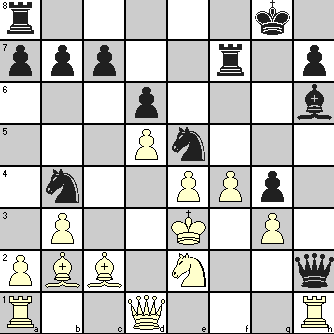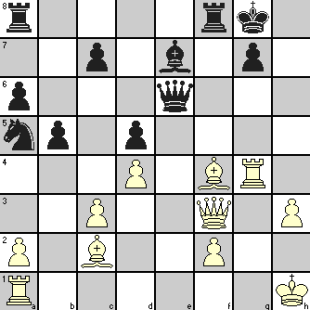In my view, all chess players get some inspirational ideas from time to time enabling them to produce that game of a lifetime! But since you will like to win on other days also, you cannot solely depend on that stroke of imaginative tactical ideas. You have to find some ways to make your perception work for you to produce, if not a brilliancy, at least a good combination or chess tactics whereby you get an upper hand over your opponent. In Chess Tactics: Method Approach to Calculating Combinations, we presented some methodical approach to find chess tactics that can yield better results on an average.
Lest you come to a wrong conclusion of this being a surefire way to create your combinations, we again stress that the method approach to chess tactics may not be possible for all situations by average players. In several earlier discussions, we have shown where even top Grandmasters could not find the winning move in a particular situation. You may go through Chess Tactics: The role of memory to see how Smyslov failed to find the move that enabled Chigorin to win in a similar situation 40 years earlier.
One of the reasons of failing to see some combinations is our mental block on certain possibilities. A Queen is such an important piece that we automatically assume that when the Queen is under attack by a Pawn/Knight/Bishop/Rook, the defender will try to protect it. That the Queen may have been marked for a sacrifice generally escapes our mind.
Let us see if the method approach would enable us to find the combination employed by Nezhmetdinov against Polugayevsky in the diagram position that was discussed in Importance of chess strategy – Part 2.

In the referred article, you have seen how the game proceeded after White had accepted the Queen sacrifice. Let us see if we can find what prompted Black to make the sacrifice.
Using the system we discussed in Chess Tactics: Method Approach to Calculating Combinations, what can you see in the above position? What are the escape squares for White King? Only d2 and d4, but d2 will not be available if the White Knight moved, which can be induced by an attack on the f4 pawn in the firing line of Black’s Bishop and Rook. Once the Knight moves, Black King loses the escape hole at d2 and now a check by Nxc2+ will take away d4 also. So the King gets checkmated unless White Queen is forced to capture the Knight by Qxc2, and that means losing the Queen because of Black’s Qxc2 with mate threat still looming large!
Therefore, you would expect White to capture the Queen, may be just because it is available (!) or because of seeing through aforesaid combination. After Black plays Rxf4, White has to decide between capturing Black Queen or Black Rook! We have seen how capturing the Rook affects White (he may resist moving the Knight by playing gxf4 but then Bxf4+ leaves no alternative!) and so we would bank on White’s Rxh2. We need not break our head on further analysis as Nezhmetdinov showed the way! (Refer Importance of chess strategy – Part 2)
Are we getting somewhere in using this type of method approach? Let us take up another example to see if it helps there also.

On previous move, White QB captured a pawn at f4, forcing Black to move his Queen from h6 to e6. It is White’s turn now. It will be apparent that Black is not posing any worthwhile threat. Black King has only three escape holes at f7, h7 and h8 in case of a check along g-file, possible by Rxg7 and then by Rg1 (after the King captures the Rook). White Queen can move to h5 square with check to deny all those three squares to Black King if it moves to f7 and Black’s Queen and other pieces are unable to prevent it. If the King tries to move to f6 instead of f7, White Bishop can move to e5 to deliver double check and that is the end of it. So the moves are clear:
1. Rxg7+ Kxg7
2. Rg1+ Kf7
3. Qh5+ Kf6
4. Qg6#
In the actual game played between Lasker and Teichmann at St. Petersburg in 1909, Teichmann resigned after White’s Rxg7+ as he could see what was coming.


2 Comments
how can improve my chess , how does 1 go by registering international tournaments ?
@Cowen
To achieve what you want (participate in tournaments), the process has to go through certain steps.
In absence of information like your country of residence, current status (meaning if you are a student in a school or college or working in some profession) etc., the answer becomes too broadbased. If you are a student, you should join chess tournaments in your school/college and assuming you do well, you get selected by your institution to represent it in county level or state level or national level inter-school or inter-college tournaments. The same could hold if you are working and your organization has a chess club that participates in inter-office tournaments.
In general, the best course is to become a member of the chess federation of your country, who generally have affiliates at state levels also. You should also join a locak chess club that is affiliated to the national federation.
Once a member, you are entitled to many member privileges and can play in the chess club who may have players rated higher than you. You can get good practice to improve your game.
If you are short of time during the regular hours because of your profession, you can take part in correspondence chess also and many of these are rated where you can score points.
Assuming you are from USA, you can visit
https://secure2.uschess.org/webstore/tournament.php?mode.x=12&mode.y=15
to know about participation in tournaments.
To become a member, you may take a look at
http://main.uschess.org/component/option,com_wrapper/Itemid,323/
You may also check
http://main.uschess.org/content/view/7328
to find answers to common questions.
If you happen to be in some other country, find the website of your country’s chess federation through net search. There you will possibly find all the information you are looking for.
Trackbacks/Pingbacks